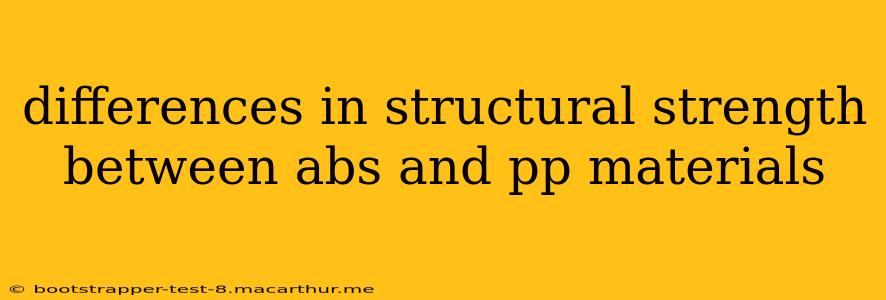Acrylonitrile butadiene styrene (ABS) and polypropylene (PP) are both common thermoplastic polymers used in a wide variety of applications, from consumer goods to automotive parts. While both are strong and durable, they possess distinct differences in their structural strength characteristics, making them suitable for different purposes. Understanding these differences is crucial for selecting the right material for a given application.
What is ABS?
ABS is a terpolymer—a polymer made from three monomers: acrylonitrile, butadiene, and styrene. This unique composition gives ABS a combination of properties: the strength and rigidity of styrene, the impact resistance of butadiene, and the chemical resistance of acrylonitrile. This results in a material that is tough, durable, and resistant to many chemicals and solvents.
What is PP?
Polypropylene (PP) is a thermoplastic polymer made from the polymerization of propylene monomers. It's known for its versatility, lightweight nature, and good chemical resistance. Several grades of PP exist, each with varying levels of strength and stiffness. Homopolymer PP is stiffer and more brittle than random copolymer PP, which is more flexible and impact-resistant.
Comparing the Structural Strength of ABS and PP
While both ABS and PP are strong, their strength characteristics differ significantly in several key aspects:
Impact Strength
ABS generally boasts superior impact strength compared to PP. This means ABS can withstand sudden shocks and impacts better than PP, exhibiting higher resistance to cracking or breaking under stress. This advantage makes ABS ideal for applications requiring high impact resistance, such as protective casings for electronics or components in automotive applications.
Tensile Strength
Tensile strength, the ability to resist being pulled apart, is comparable between ABS and PP, although specific values vary depending on the grade and processing method of each material. Both can exhibit good tensile strength, but the choice often depends on other factors beyond just tensile strength alone.
Flexural Strength
Flexural strength, or the ability to resist bending, is generally higher in ABS compared to PP. This means ABS can withstand more bending stress before breaking or deforming. This is another reason ABS is preferred in applications where bending loads are anticipated.
Stiffness
PP generally offers higher stiffness than ABS. This means PP is less prone to bending or flexing under load. This makes PP suitable for applications requiring rigidity, such as certain types of containers or structural components.
Heat Resistance
PP typically has a higher heat deflection temperature (HDT) than ABS, indicating better heat resistance. This means PP can withstand higher temperatures without significant deformation. This is an important consideration in high-temperature applications.
Chemical Resistance
Both ABS and PP offer good chemical resistance, but their resistance varies depending on the specific chemical. Generally, PP exhibits better resistance to certain chemicals compared to ABS. It is crucial to check the specific chemical resistance of each material grade when selecting one for a particular application.
Which Material is Stronger? It Depends!
There's no single definitive answer to which material, ABS or PP, is "stronger." The superior material depends entirely on the specific type of stress it needs to withstand and the requirements of the application. ABS shines where high impact strength and flexural strength are needed, while PP is favored for applications demanding stiffness, heat resistance, and often, cost-effectiveness. Careful consideration of the relevant mechanical properties is essential for appropriate material selection.
Frequently Asked Questions
How does the manufacturing process affect the strength of ABS and PP?
The manufacturing process significantly influences the final strength of both ABS and PP. Factors such as injection molding parameters (temperature, pressure, injection speed), the addition of fillers or reinforcements (e.g., glass fibers), and post-processing treatments (e.g., annealing) can all affect the material's mechanical properties.
Are there any environmental concerns regarding ABS and PP?
Both ABS and PP are thermoplastics, meaning they can be recycled. However, the recycling process can be challenging, and not all ABS and PP are easily recyclable depending on the grade and additives. The use of virgin materials and exploration of more sustainable alternatives should be considered in line with environmental impact assessments.
What are some common applications for ABS and PP?
ABS is often used in automotive parts, appliances, luggage, and protective casings. PP is commonly used in packaging, containers, automotive parts, textiles, and medical devices.
By understanding the nuances of these materials’ properties and considering the application’s specific needs, engineers and designers can make informed decisions about which material—ABS or PP—will best ensure structural integrity and longevity.
